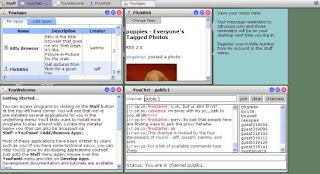 Hacking has been around for more than a century. In the 1970s, several teenagers were flung off the country's brand new phone system by enraged authorities. Here's a peek at how busy hackers have been in the past 35 years.
Hacking has been around for more than a century. In the 1970s, several teenagers were flung off the country's brand new phone system by enraged authorities. Here's a peek at how busy hackers have been in the past 35 years. Early 1960s
University facilities with huge mainframe computers, like MIT's artificial intelligence lab, become staging grounds for hackers. At first, "hacker" was a positive term for a person with a mastery of computers who could push programs beyond what they were designed to do.
Early 1970s
John Draper makes a long-distance call for free by blowing a precise tone into a telephone that tells the phone system to open a line. Draper discovered the whistle as a give-away in a box of children's cereal. Draper, who later earns the handle "Captain Crunch," is arrested repeatedly for phone tampering throughout the 1970s. John Draper
Yippie social movement starts YIPL/TAP (Youth International Party Line/Technical Assistance Program) magazine to help phone hackers (called "phreaks") make free long-distance calls.
Two members of California's Homebrew Computer Club begin making "blue boxes," devices used to hack into the phone system. The members, who adopt handles "Berkeley Blue" (Steve Jobs) and "Oak Toebark" (Steve Wozniak), later go on to found Apple Computer.
Early 1980s
Author William Gibson coins the term "cyberspace" in a science fiction novel called Neuromancer.
In one of the first arrests of hackers, the FBI busts the Milwaukee-based 414s (named after the local area code) after members are accused of 60 computer break-ins ranging from Memorial Sloan-Kettering Cancer Center to Los Alamos National Laboratory.
Comprehensive Crime Control Act gives Secret Service jurisdiction over credit card and computer fraud.
Two hacker groups form, the Legion of Doom in the United States and the Chaos Computer Club in Germany.
2600: The Hacker Quarterly is founded to share tips on phone and computer hacking.
Late 1980s
The Computer Fraud and Abuse Act gives more clout to federal authorities.
Computer Emergency Response Team is formed by U.S. defense agencies. Based at Carnegie Mellon University in Pittsburgh, its mission is to investigate the growing volume of attacks on computer networks.
At 25, veteran hacker Kevin Mitnick secretly monitors the e-mail of MCI and Digital Equipment security officials. He is convicted of damaging computers and stealing software and is sentenced to one year in prison.
First National Bank of Chicago is the victim of a $70-million computer heist.
An Indiana hacker known as "Fry Guy" -- so named for hacking McDonald's -- is raided by law enforcement. A similar sweep occurs in Atlanta for Legion of Doom hackers known by the handles "Prophet," "Leftist" and "Urvile."
After AT&T long-distance service crashes on Martin Luther King Jr. Day, law enforcement starts a national crackdown on hackers. The feds nab St. Louis' "Knight Lightning" and in New York grab Masters of Deception trio "Phiber Optik," " Acid Phreak" and "Scorpion." Fellow hacker "Eric Bloodaxe" is picked up in Austin, Texas.
Operation Sundevil, a special team of Secret Service agents and members of Arizona's organized crime unit, conducts raids in 12 major cities, including Miami.
A 17-month search ends in the capture of hacker Kevin Lee Poulsen ("Dark Dante"), who is indicted for stealing military documents.
Hackers break into Griffith Air Force Base, then pewwwte computers at NASA and the Korean Atomic Research Institute. Scotland Yard nabs "Data Stream," a 16-year-old British teenager who curls up in the fetal position when seized.
A Texas A&M professor receives death threats after a hacker logs on to his computer from off-campus and sends 20,000 racist e-mail messages using his Internet address.
| Kevin Mitnick [photo / AP ] |
Late 1990s
Hackers break into and deface federal Web sites, including the U.S. Department of Justice, U.S. Air Force, CIA, NASA and others.
Report by the General Accounting Office finds Defense Department computers sustained 250,000 attacks by hackers in 1995 alone.
A Canadian hacker group called the Brotherhood, angry at hackers being falsely accused of electronically stalking a Canadian family, break into the Canadian Broadcasting Corp. Web site and leave message: "The media are liars." Family's own 15-year-old son eventually is identified as stalking culprit.
Hackers pierce security in Microsoft's NT operating system to illustrate its weaknesses.
Popular Internet search engine Yahoo! is hit by hackers claiming a "logic bomb" will go off in the PCs of Yahoo!'s users on Christmas Day 1997 unless Kevin Mitnick is released from prison. "There is no virus," Yahoo! spokeswoman Diane Hunt said.
1998
Anti-hacker ad runs during Super Bowl XXXII. The Network Associates ad, costing $1.3-million for 30 seconds, shows two Russian missile silo crewmen worrying that a computer order to launch missiles may have come from a hacker. They decide to blow up the world anyway.
In January, the federal Bureau of Labor Statistics is inundated for days with hundreds of thousands of fake information requests, a hacker attack called "spamming."
Hackers break into United Nation's Children Fund Web site, threatening a "holocaust" if Kevin Mitnick is not freed.
Hackers claim to have broken into a Pentagon network and stolen software for a military satellite system. They threaten to sell the software to terrorists.
The U.S. Justice Department unveils National Infrastructure Protection Center, which is given a mission to protect the nation's telecommunications, technology and transportation systems from hackers.
Hacker group L0pht, in testimony before Congress, warns it could shut down nationwide access to the Internet in less than 30 minutes. The group urges stronger security measures.
Today in the senario of internet no body is safe there are some loopholes in every system. The Hackers are always giving their time to Pick Up The Right One....
BE SAFE.....Use Open Source System







